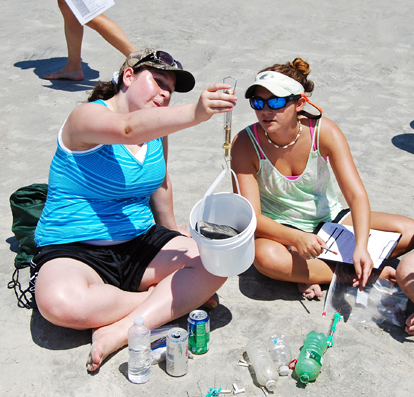No part of the Georgia coast is protected from pollution by plastics and other marine debris. That is one finding of a study conducted by Skidaway Institute of Oceanography scientists Jay Brandes and Dick Lee.
The scientists studied the collection totals from beach clean-up programs by environmental groups like Clean Coast and the Tybee Beautification Association and Rivers Alive. They found that while beach-sweep programs at populated spots like Tybee Island collect the most plastic, even sweeps in relatively remote locations like Cumberland and Ossabaw Islands collect a sizeable haul. A 2007 beach sweep on Tybee by the Tybee Beautification Association and Rivers Alive collected 5,400 pounds of plastic. In similar clean-ups by Clean Coast in 2009, volunteers collected 1,100 pounds on Cumberland Island and 750 pounds on Ossabaw Island.
The places with the largest amount of plastics accumulation were Tybee Island, Little Tybee Island, Turner’s Creek and Pigeon Island.
“It is interesting that some of the beaches receiving relatively low numbers of visitors, such as Blackbeard Island and Cumberland Island, still have relatively high amounts of plastic debris,” Brandes said. “This suggests that the source of plastics on remote beaches is the surrounding coastal waters that contain plastics from both inland and the coast.”
The Skidaway Institute researchers focused their attention on plastics for several reasons. Plastics tend to be very durable and persist in the environment for long periods of time. Also, relatively small pieces of plastic can be a threat to marine animals. Fish sometime eat the plastics, which can block their digestive systems. Sometimes harmful contaminants tend to cling to plastic and can be ingested when the plastic is eaten.
“Plastics pollution has been getting a lot of attention recently, especially those large gyres, like the Great Pacific Garbage Patch,” said Brandes. “But most of those plastics are coming from land and that means that most of the plastic in our environment is going to remain near the shore.”
For this study, the scientists were restricted to analyzing data provided by the various beach clean-up groups. The problem is these groups are, understandably, usually more concerned about cleaning up the beach than sorting types of debris they collect. Based on earlier studies of marine debris and limited sorting that has been done during some cleanups, the research team worked under the assumption that one half of the total material collected was comprised of plastics.
The plastics problem is not limited to coolers and plastic cups. According to Brandes, many of the larger plastic objects eventually become broken down into smaller pieces, as tiny as a grain of sand. They may remain suspended in the water column. Brandes has found these micro-plastic particles while collecting samples for other projects.
“Right now, very little is known about what kind of impact these micro-plastics might be having on fish or other parts of the marine ecosystem,” said Brandes.

Students in the Marine Debris program weight some of the material they have collected on the north beach of Wassaw Island.
To help with the problem of understanding what kinds of plastics foul our beaches and marshes, Skidaway Institute scientists are collecting additional data on marine plastics and other debris though a cooperative educational program, “Marine Debris,” with the University of Georgia Marine Extension Service.
“Marine Debris” is a hands-on, interactive program that incorporates the topic of marine debris with an emphasis on plastic debris along the coast of Georgia. Students and their teachers are conducting shoreline marine debris surveys on Wassaw Island to determine types of marine debris, weight of plastics collected and accumulation rates for the designated site. The students are compiling the data using the National Oceanographic and Atmospheric Administration Accumulation Survey protocol. The data is being submitted to the Southeast Marine Debris Initiative data base.


